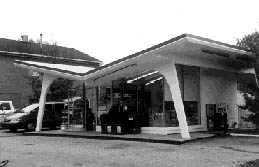
One goal of the Heinz Architectural Center at Carnegie Museum of Art is to enhance the understanding and appreciation of the architecture of Western Pennsylvania. An important new project taking place at the Center will go a long way toward achieving this goal. Work has begun on a guidebook to the architecture of the region. The Buildings of Western Pennsylvania will be part of a series organized by the Society of Architectural Historians and published by Oxford University Press.
The series will serve as a resource for scholarship in architectural history, teaching, preservation, history and urban planning. At the same time, it will address a general public interested in architecture. Volumes in the series are designed as guides as well as reference books with descriptions keyed to maps and photographs accompanying many of the individual entries. Along with such high-style building types as houses, churches, state houses and theaters, the books will include utilitarian and vernacular building types ranging from factories and bridges to barns and gas stations.
The primary intent of this series is to evoke the essential character of each state as seen through its architecture, and local practitioners; styles and trends will be related to those of the nation as a whole. The first four volumes-for the states of Iowa, Michigan, Alaska and the District of Columbia-were published in 1992. Colorado was published in early 1997. Those in preparation include Western Pennsylvania, Rhode Island, Virginia, West Virginia, Connecticut, Wisconsin, Louisiana, Vermont, Missouri and Nevada.
The Western Pennsylvania volume will cover the important architecture in 33 counties of the western portion of the state. Headquartered at the Heinz Architectural Center, our project team has already conducted field studies in Beaver, Greene, Lawrence, Westmoreland, Fayette, Cambria and Indiana counties, which contain a richness and variety of architecture that extends from the 1802 "stone pile" of Greensburg Academy to the 1977/1987 cooling towers of the Shippingport Nuclear Reactor. Many of the individual sites and districts of Beaver County, for example, illustrate important themes-the prevalence of Presbyterianism in the early 19th century, the engineering of company towns around thriving steel mills and coal mines and the evolution and dissolution of once-sizable family farms. In addition to these specific themes, travels through western counties reveal the similarity of a large number of domestic buildings. These sites strongly suggest a coherent pattern of building that will be evaluated throughout our field research, and which may emerge as a Western Pennsylvania vernacular architecture.
One of the most interesting sites that we have researched in Beaver County is the historic Old Economy, founded in 1825 by the Harmonists, a German Separatist sect. The district contains significant brick and frame houses, shops and communal buildings, many with Swabian architectural overtones. The Harmonists' influence was not limited to their close-knit society, but spread beyond the confines of the commune to influence the art, industry and economy of Beaver County. With holdings in several banks, factories and the P&LE Railroad, the Harmonists' contributions to the development of the county was substantial and includes the planning of the cities of Beaver Falls and Monaca.
Also working on this book project are research assistants Laura Ricketts and Clinton Piper, and Carnegie Mellon University student Peter Moore, who is spending his internship studying the architecture of Lawrence County. Professor Deryck Holdsworth of Pennsylvania State University has agreed to investigate the counties around State College in the center of the state.
Funding for the first phase of Buildings of the United States was provided by the National Endowment for the Humanities, the Pew Charitable Trusts, the Graham Foundation for the Advanced Studies in the Fine Arts and private foundations including the Getty Grant Program. The Society of Architectural Historians secured funding for the Western Pennsylvania volume from an anonymous source.
Lu Donnelly is director of the Buildings of Western Pennsylvania project.